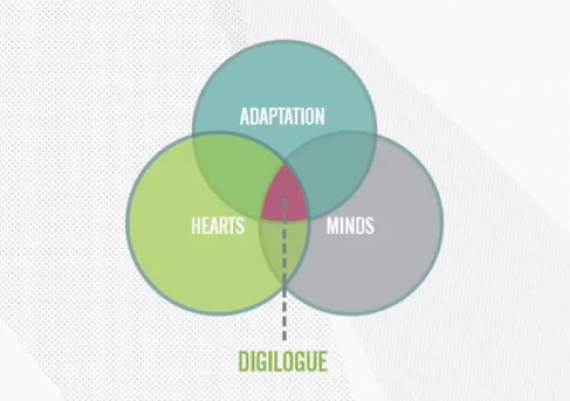Foresights and ideas that expand minds and inspire a change of heart.

On a late autumnal day in NYC in 2011, a New Zealand-made Icebreaker hoodie was keeping me warm at the starting line of the NYC Marathon. Natural high tech fibres. What? Yep, Merino wool from the Southern Alps of New Zealand. Middle Earth country. You wear wool when you run? Yep, of course. I had received this amazing sporting hoodie at TEDGlobal 2011 in Edinburgh, and I love it. It keeps me warm in winter, and cool in summer. All natural fibre, yet still high tech.
It has to be because Icebreaker competes with the best synthetic outdoor sports apparel and clothing in the world. It's a competitor of Patagonia and North Face. The company is truly digilogue. It is channelling the energy from the convergence of the digital and the analogue. How? Its founder, Jeremy Moon, a cultural anthropologist, was given a pair of Merino jockeys in 1994. At the time, Merino wool was considered such a commodity that it was frequently blended with traditional wool.
They were not, and Jeremy's business idea was hatched. Nicely designed undergarments and performance garments for tough environments. Designed from nature. Utilising the adaptation of the Merino sheep to the New Zealand alpine environment. Taking a thread which had been used by Italian suitmakers for decades, and applying it in a different context. Genius. As an anthropologist, Moon was tuned into the consumer insight that outdoor people and nature fanatics want natural materials, preferably sustainable eco-materials. They also want high performance, and up until the rise of Icebreaker synthetics had had some advantages on the performance side.

This digilogue approach enabled Icebreaker to double in size during the global financial meltdown. It has won both hearts and minds around the world. The company, privately held, sells its outfits in 3000 stores across more than 30 countries. At a time when retail across the Western world has been digitally decimated, Icebreaker has gone from strength to strength. The marketing focusses both on how the clothing is worn, but also how it's born. This enabled it to turn a feature with Sarah Palin - sporting one of its jumpers - on the front cover of Newsweek to its advantage. The title of the article: "How do you solve a problem like Sarah? She is bad news for the GOP - and for everyone else, too". Moon's reaction: Palin looked both ‘smart and hot'. The company is extremely focussed, and strong at each stage of its supply chain. Its brand's story telling begins with its supply chain. What? You mean it uses the unsexy area of supply chain management in its branding.
This code enables you to track your garment back to the farm from which the Merino came. On the website, you can digitally access a YouTube video featuring the farmer, his family, and their sheep. You can view maps of the location, the statistics on the farm, and its history. High tech. High Touch. Phenomenal stuff.

This is the story of how an animal which grows in rugged, natural conditions, can help humans escape into rugged, natural conditions. There is something pastoral to this. A sense of analogue human and animal interaction. Of being at one. Of disconnecting from the high tech urban world, by reconnecting with nature. It's about form and function. Of design aesthetic and functional ruggedness. What makes the story and brand so engaging is that the story is traceable and not mere spin. Icebreaker prides itself on having long term partnerships through the supply chain, and works with Merino wool farmers on a long term contractual basis which gives the farmers certainty and market access in a long term fashion, and ensures supply and high quality for Icebreaker. This also enables Icebreaker to track batches of wool in a digital way, so that it can tell its analogue marketing story. This digilogue branding has helped turn a commodity, Merino wool, into a premium product. And the product doesn't come cheap. But it engages digital minds, and analogue hearts, and of course we want to pay extra for the jumper brought to you by farmer Ray Anderson from Branch Creek and his sheep.
What do I mean by this? History gets to live on because the company is future-minded. It uses technology to tell the story. It uses technology to transparently market its supply chain. It uses technology to shine a torch on otherwise media shy farmers who they collaborate with. It is not surprising that the company is led by an anthropologist like Jeremy Moon. He thinks about anthropology as much as he thinks about technology. Anthropology is the study of humankind, in particular it is the comparative study of human societies and cultures and their development. Anthropologists like Jeremy Moon, and my friend Michael Henderson in New Zealand, are by their own admission, obsessive about observation. Through observation of consumer patterns, by observing the value chain and partnership dynamics, and by observing the tribal needs of farmers, Moon was able to spot an opportunity. As my futurist colleague, Mike Walsh says, in our rush to innovate and think about the future, we mustn't just think technology, we must also think anthropology. In this instance the anthropological observation of the old, of culture, of story, of heritage, of place, of provenance, got amplified by technological savvy. Digital and analogue converging. This is critical not just from a business perspective, because what Moon enables here is for culture, tradition and a particular language to be handed down generationally. The new school enables the old school.

Header Text
Lorem ipsum dolor sit amet, consectetur adipiscing elit, sed do eiusmod tempor incididunt ut labore et dolore magna aliqua. Ut enim ad minim veniam, quis nostrud exercitation ullamco laboris nisi ut aliquip ex ea commodo consequat. Duis aute irure dolor in reprehenderit in voluptate velit esse cillum dolore eu fugiat nulla pariatur.
Lorem ipsum dolor sit amet, consectetur adipiscing elit, sed do eiusmod tempor incididunt ut labore et dolore magna aliqua. Ut enim ad minim veniam, quis nostrud exercitation ullamco laboris nisi ut aliquip ex ea commodo consequat. Duis aute irure dolor in reprehenderit in voluptate velit esse cillum dolore eu fugiat nulla pariatur.
Lorem ipsum dolor sit amet, consectetur adipiscing elit, sed do eiusmod tempor incididunt ut labore et dolore magna aliqua. Ut enim ad minim veniam, quis nostrud exercitation ullamco laboris nisi ut aliquip ex ea commodo consequat. Duis aute irure dolor in reprehenderit in voluptate velit esse cillum dolore eu fugiat nulla pariatur.

Header Text
Lorem ipsum dolor sit amet, consectetur adipiscing elit, sed do eiusmod tempor incididunt ut labore et dolore magna aliqua. Ut enim ad minim veniam, quis nostrud exercitation ullamco laboris nisi ut aliquip ex ea commodo consequat. Duis aute irure dolor in reprehenderit in voluptate velit esse cillum dolore eu fugiat nulla pariatur.
Lorem ipsum dolor sit amet, consectetur adipiscing elit, sed do eiusmod tempor incididunt ut labore et dolore magna aliqua. Ut enim ad minim veniam, quis nostrud exercitation ullamco laboris nisi ut aliquip ex ea commodo consequat. Duis aute irure dolor in reprehenderit in voluptate velit esse cillum dolore eu fugiat nulla pariatur.
Lorem ipsum dolor sit amet, consectetur adipiscing elit, sed do eiusmod tempor incididunt ut labore et dolore magna aliqua. Ut enim ad minim veniam, quis nostrud exercitation ullamco laboris nisi ut aliquip ex ea commodo consequat. Duis aute irure dolor in reprehenderit in voluptate velit esse cillum dolore eu fugiat nulla pariatur.

Header Text
Lorem ipsum dolor sit amet, consectetur adipiscing elit, sed do eiusmod tempor incididunt ut labore et dolore magna aliqua. Ut enim ad minim veniam, quis nostrud exercitation ullamco laboris nisi ut aliquip ex ea commodo consequat. Duis aute irure dolor in reprehenderit in voluptate velit esse cillum dolore eu fugiat nulla pariatur.
Lorem ipsum dolor sit amet, consectetur adipiscing elit, sed do eiusmod tempor incididunt ut labore et dolore magna aliqua. Ut enim ad minim veniam, quis nostrud exercitation ullamco laboris nisi ut aliquip ex ea commodo consequat. Duis aute irure dolor in reprehenderit in voluptate velit esse cillum dolore eu fugiat nulla pariatur.
Lorem ipsum dolor sit amet, consectetur adipiscing elit, sed do eiusmod tempor incididunt ut labore et dolore magna aliqua. Ut enim ad minim veniam, quis nostrud exercitation ullamco laboris nisi ut aliquip ex ea commodo consequat. Duis aute irure dolor in reprehenderit in voluptate velit esse cillum dolore eu fugiat nulla pariatur.
& STAY UP TO DATE WITH FORESIGHTS AND TREND REPORTS!
WE WILL EQUIP YOU WITH THE VIDEOS AND MATERIALS YOU NEED TO SUCCESSFULLY PITCH ASN.
0 Comment